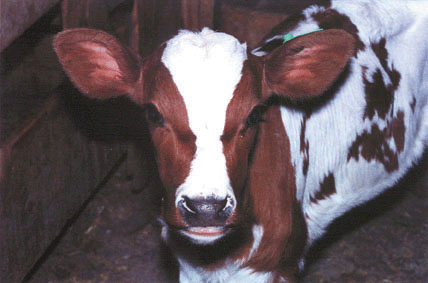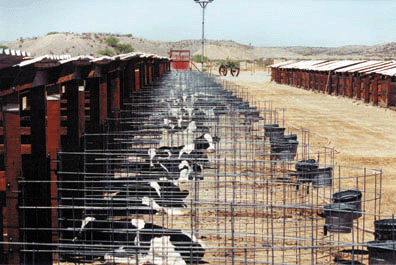Guide D-208
Michael Looper, NMSU Extension Dairy SpecialistSandra R. Stokes, Extension Dairy Specialist, The Texas A&M University System
Dan N. Waldner, Extension Dairy Specialist, Oklahoma State University; and
Ellen R. Jordan, Extension Dairy Specialist, The Texas A&M University System.
College of Agriculture, Consumer and Environmental Sciences New Mexico State University. (Print Friendly PDF)
This Publication is scheduled to be updated and reissued 4/06.
Dairy producers feed a variety of liquid feeds to young calves after the initial colostrum. These feeds include whole milk, surplus colostrum, transition milk, waste or discard milk, and milk replacer. Waste or discard milk cannot be sold for human consumption, because it comes from cows treated with antibiotics for mastitis or other illnesses.
Discard milk losses range from 48 to 136 pounds of milk per cow per year (Blosser, 1979). To reduce some of the economic loss, 38 percent of dairy producers feed waste milk to calves (Heinrichs et al., 1994).
However, many dairy producers avoid feeding waste milk to calves for fear of increasing calf morbidity (Schaffer and McGuffey, 1980) or the incidence of heifers calving with mastitis or blind quarters (Kesler, 1981). In early studies, calves generally were housed in pens that enabled them to suckle the rudimentary teats of other calves. This led to an increase in the incidence of mastitis in developing heifers.
Research shows that calves fed waste milk have growth rates and incidences of scouring that are similar to milk-fed controls (Chardavoyne et al., 1979; Keys et al., 1980; Kesler, 1981).
Precautions for Feeding Waste Milk
Waste milk can be a safe liquid feed for calves provided certain precautions are followed (Kesler, 1981).
- Do not feed waste milk to newborn calves on the first day of life. The intestinal wall is permeable to bacteria that could cause illness.
- House calves fed waste milk individually to prevent them from suckling one another. This should reduce the transmission of infectious microorganisms that cause mastitis.
- Use caution when feeding waste milk from antibiotic-treated cows to calves intended for meat production. Antibiotic residues from the milk could be deposited in the calves' tissues.
Waste Milk Storage
When handling large quantities of waste milk, dairy operators need to have the proper equipment. Obtain a small, used bulk tank to store the waste milk produced daily. This allows pooling of all waste milk sources (mastitis and/or transition milk, etc.) and reduces the chances of feeding excessive amounts of antibiotic milk in one feeding (Davis and Drackley, 1998). Clean the tank at least every other day.
Pasteurization of Waste Milk Fed to Calves
Young calves are susceptible to diseases. That's why it is important to know the complete health status of introduced cows when expanding herds or buying replacements. Feeding milk fromcows of unknown health status could be detrimental to the calves' health.
Pasteurization safely decreases pathogens in all types of milk fed to young calves. Recently, University of California at Davis researchers (Jamaluddin et al., 1996) reported that calves fed pasteurized milk had fewer days with diarrhea and pneumonia than calves fed nonpasteurized milk. Also, calves fed pasteurized milk had greater average weight gain than calves fed nonpasteurized milk. Calves fed pasteurized milk grossed an extra $8.13 per head, attributed to reduced health complications and treatment costs, when compared with calves fed nonpasteurized milk. The researchers calculated that 315 calves (from a dairy of approximately 1,260 cows) need to be fed daily to make pasteurization economically feasible.

Waste milk is an economical and nutritious source of liquid feed for young dairy calves if handled properly.
Research from the National Animal Disease Center (USDA; Stabel et al., 1997) showed that pasteurization of milk at 162° F (72°C) for 15 seconds killed all Mycobacterium paratuberculosis, the bacteria responsible for Johne's disease. To effectively destroy M. paratuberculosis in milk, a continuous-flow (turbulent) pasteurizer is necessary (Stabel et al., 1997). A continuous-flow pasteurizer quickly heats and holds milk at temperatures that kill bacteria. The milk is then quickly cooled, maintaining the nutritional components and flavor. Bacterial organisms in milk may clump together and not be pasteurized with a batch-type (static) pasteurization system.
While it is recommended that waste milk be pasteurized, pasteurizing colostrum is discouraged. The elevated temperatures associated with pasteurization can destroy immunoglobulins that are important for passive immunity transfer to young calves (Quigley, 1998). Also, colostrum is more dense than milk, which makes it more difficult to raise pasteurization temperatures high enough to kill bacterial organisms, such as M. paratuberculosis.
Several bacterial organisms, including E. coli, bovine viral diarrhea (BVD), salmonella, Streptococcus species and Staphylococcus species, have been identified in waste milk (Selim and Cullor, 1997). Pasteurizing waste milk reduces microbial loads before use as calf feeds. Pasteurization destroys mycoplasma mastitis species, eliminating mycoplasma transmission to calves (Butler et al., 2000). Similarly, pasteurization destroys bovine leukosis virus (BLV), so pasteurized milk from BLV-positive cows can be fed to calves when BLV-free milk is not available (Pelzer and Sprecher, 1993). Although pasteurization reduces the microbial load of waste milk, pasteurization is not sterilization. A heavy bacterial load in waste milk will not be eliminated completely by pasteurization. Also, pasteurization does not remove potential contamination from antibiotics in waste milk.

House heifer calves separately when feeding waste milk.
Usage Guidelines
Milk from transition and sick cows cannot be sold and must be discarded. Waste milk can be fed to calves, but a few precautions must be followed.
- Before using as a calf feed, pasteurize waste milk to reduce microbial load.
- Do not feed waste milk to newborn calves.
- Use caution when feeding waste milk to calves that are destined for beef production.
- House heifer calves individually (for example, hutches) when feeding waste milk.
- Know the health status of the cows from which waste milk is obtained. Unless milk is pasteurized, do not feed milk from cows shedding BVD or Johne's or from cows infected with E. coli, Pasteurella or BLV.
- Don't allow waste milk to sit for an extended time without refrigeration.
- Discard waste milk that is excessively bloody, watery or unusual in appearance.
Calves fed pasteurized waste milk have fewer illnesses than those fed unpasteurized waste milk. If handled properly, waste milk is an economical and nutritious source of liquid feed for young dairy calves.
References
Blosser, T. H. 1979. Economic losses from and the national research program on mastitis in the United States. J. Dairy Sci. 62:119-127.
Butler, J. A., S. A. Sickles, C. J. Johanns, and R. F. Rosenbusch. 2000. Pasteurization of discard mycoplasma mastitic milk used to feed calves: thermal effects on various mycoplasma. J. Dairy Sci. 83:2285-2288.
Chardavoyne, J. R., J. A. Ibeawuchi, E. M. Kesler, and K. M. Borland. 1979. Waste milk from antibiotic treated cows as feed for young calves. J. Dairy Sci. 62:1285-1289.
Davis, C. L., and J. K. Drackley. 1998. Liquid feeding programs. In:The Development, Nutrition, and Management of the Young Calf. Iowa State University Press, Ames. pp. 259-282.
Heinrichs, A. J., S. J. Wells, H. S. Hurd, G. W. Hill, and D. A. Dargatz. 1994. The National Dairy Heifer Evaluation Project: A profile of heifer management practices in the United States. J. Dairy Sci. 77:1548-1555.
Jamaluddin, A. A., T. E. Carpenter, D. W. Hird, and M. C. Thurmond. 1996. Economics of feeding pasteurized colostrum and pasteurized waste milk to dairy calves. J. Amer. Vet. Med. Assoc. 209:751-756.
Kesler, E. M. 1981. Feeding mastitic milk to calves: a review. J. Dairy Sci. 64:719-723.
Keys, J. E., R. E. Pearson, and B. T. Weinland. 1980. Performance of calves fed fermented mastitic milk, colostrum, and fresh whole milk. J. Dairy Sci. 63:1123-1127.
Pelzer, K. D., and D. J. Sprecher. 1993. Controlling BLV infection on dairy operations. Vet. Med. 3:275-279.
Quigley, J. 1998. Colostrum from Johne's positive cows. Calf Notes #51. www.americanprotein.com/calf/calfnotes/APCCN51.htm.
Schaffer, L. V., and R. K. McGuffey. 1980. Effects of feeding mastitic milk to calves. Proc. Nat. Mastitis Council. 19:67-69.
Selim, S. A., and J. S. Cullor. 1997. Number of viable bacteria and presumptive antibiotic residues in milk fed to calves on commercial dairies. J. Amer. Vet. Med. Assoc. 211:1029-1035.
Stabel, J. R., E. M. Steadham, and C. A. Bolin. 1997. Heat inactivation of Mycobacterium paratuberculosis in raw milk: Are current pasteurization conditions effective? Appl. Environ. Microbiol. 63:4975-4977.
New Mexico State University is an equal opportunity/affirmative action employer and educator. NMSU and the U.S. Department of Agriculture cooperating.
April 2001
Electronic Distribution April 2001


